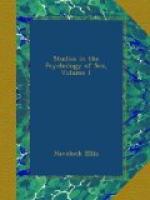In another case known to me,
a young man leading a chaste life,
experienced crises of sexual
excitement every ten to fourteen
days, the crisis lasting for
several days.
Finally, an interesting contribution to this subject, suggested by this Study, has been made and published (in the proceedings of the Amsterdam International Congress of Psychology, in 1907) by the well-known Amsterdam neurologist and psychologist, Dr. L.S.A.M. Von Roemer under the title, “Ueber das Verhaeltniss zwischen Mondalter und Sexualitaet.” Von Roemer’s data are made up not of nocturnal involuntary emissions, but of the voluntary acts of sexual intercourse of an unmarried man, during a period of four years. Von Roemer believes that these, to a much greater extent than those of a married man, would be liable to periodic influence, if such exist. On making a curve of exact lunar length (similarly to Perry-Coste), he finds that there are, every month, two maxima and two minima, in a way that approximately resemble Perry-Coste’s curve. The main point in Von Roemer’s results is, however, the correspondence that he finds with the actual lunar phases; the chief maximum occurs at the time of the full moon, and the secondary maximum at the time of the new moon, the minima being at the first and fourth quarters. He hazards no theory in explanation of this coincidence, but insists on the need for further observations. It will be seen that A.N.’s results (ante p. 117) seem in the main to correspond to Von Roemer’s.
FOOTNOTES:
[117] Even counting the pulse is a comparatively recent method of physiological examination. It was not until 1450 that Nicolas of Cusa advocated counting the pulse-beats. (Binz, Deutsche medizinische Wochenschrift, October 6, 1898.)
[118] I leave this statement as it stands, though since the first publication of this book it has ceased to be strictly accurate.
[119] Sanctorius, Medicina Statica, Sect. I, aph. lxv.
[120] American Journal of Obstetrics, xiv, 1882.
[121] Zooenomia, Section XXXVI.
[122] I reproduced these notes in full in earlier editions of this volume.
[123] Moll refers to the case of a man whose erotic dreams occurred every fortnight, and always on Friday night (Libido Sexualis, Band I, p. 136). One is inclined to suspect an element of autosuggestion in such a case; still, the coincidence is noteworthy.
[124] See Durkheim, Le Suicide, p. 101.
[125] We must, of course, see here the results of the disorganization produced by holidays, and the exhaustion produced by the week’s labor; but such influences are still the social effects of the cosmic week.




